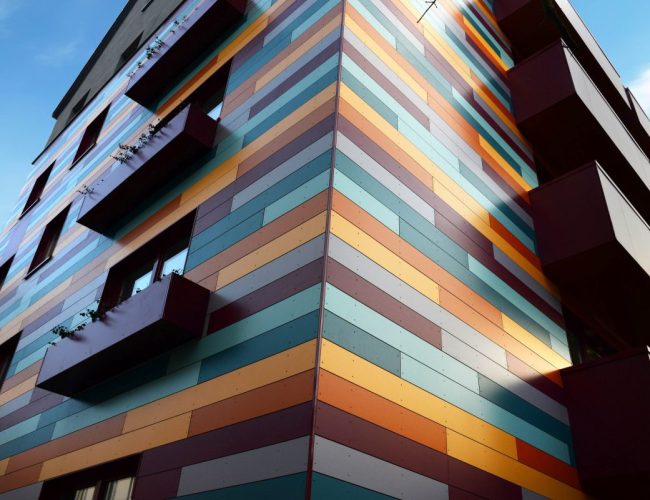Revolutionising Building Design with Aesthetic and Functional Rainscreen Cladding

In the realm of modern building design, aesthetics and functionality often go hand-in-hand, shaping structures that are not only visually appealing but also highly efficient. A prime example of this harmonious blend is the use of rainscreen cladding, a technique that has revolutionised architectural concepts and practices.
Understanding Rainscreen Cladding
Rainscreen cladding is an external envelope for buildings, designed to protect against the elements while providing a striking exterior. It typically consists of an outer panel, an air cavity for moisture drainage, and an inner layer. This structure serves multiple purposes, including moisture control and thermal insulation, making it a vital component in contemporary construction.
The Aesthetic Appeal of Rainscreen Cladding
The aesthetic versatility of rainscreen cladding is a key factor in its widespread adoption in contemporary architecture. This cladding technique allows for a broad spectrum of design choices, enabling architects to craft facades that align perfectly with their vision, whether aiming for a cutting-edge modern look or a more classic, traditional aesthetic.
Among the materials used, metal cladding offers a sleek, futuristic appearance, ideal for creating standout modern structures. Its reflective and smooth surface can be manipulated into various shapes and sizes, catering to the demands of innovative architectural designs. Wood cladding, in contrast, exudes warmth and natural beauty, lending a timeless and inviting appeal to buildings. It’s particularly favored for projects where blending with natural surroundings or creating a sense of warmth is desired.
Composite panels are another popular choice, known for their durability and wide range of finishes. These panels can mimic other materials like wood or stone or offer entirely unique textures and colors, providing immense creative freedom. Render insulation, though primarily functional, also contributes to the cladding’s visual appeal. It can be finished in various textures and hues, seamlessly integrating with the overall design while enhancing the building’s thermal efficiency.
The ability to mix and match these materials, along with the vast color and texture options, means that rainscreen cladding can be tailored to suit any architectural style. This adaptability makes it an ideal solution for both new constructions and refurbishments, where the objective is to update the building’s appearance without compromising on style or character.
Functional Benefits of Rainscreen Cladding
1. Moisture Management:
- Rainscreen cladding is instrumental in managing moisture, one of the key challenges in building maintenance.
- The system typically consists of an outer panel that deflects the majority of rainwater.
- Behind this panel, there’s an air cavity that allows any penetrating moisture to drain away or evaporate, preventing it from reaching the building’s structural walls.
- This design is crucial for preventing dampness within the building’s interior, which can lead to mold growth and structural damage.
2. Thermal Efficiency:
- The air cavity in the rainscreen cladding also plays a vital role in enhancing thermal efficiency.
- It acts as a thermal break, reducing the transfer of heat from the exterior to the interior of the building and vice versa.
- This insulation property helps in maintaining a consistent internal temperature, irrespective of external weather conditions.
- The result is a reduction in the reliance on heating and cooling systems, leading to lower energy costs and a more comfortable living or working environment.
3. Protection Against Weather Elements:
- Rainscreen cladding offers a protective barrier against various weather elements, including rain, snow, and wind.
- This protection is especially beneficial in regions with harsh weather conditions, where buildings are more susceptible to weather-related wear and tear.
4. Prevention of Structural Damage:
- By keeping the underlying structure dry and insulated, rainscreen cladding helps in prolonging the life of the building.
- It reduces the risk of structural issues caused by moisture, such as rotting in wooden elements or corrosion in metal components.
5. Contribution to Indoor Air Quality:
- By preventing moisture accumulation, rainscreen cladding indirectly contributes to better indoor air quality.
- A dry and well-insulated environment is less likely to harbor mold and mildew, which can cause health issues for occupants.
6. Energy Cost Reduction:
- The improved insulation offered by rainscreen cladding leads to significant energy savings.
- Reduced energy consumption for heating and cooling not only lowers utility bills but also decreases the carbon footprint of the building.
In summary, rainscreen cladding is a multifaceted solution that extends beyond aesthetic enhancement. Its contribution to moisture management, thermal efficiency, and overall building protection makes it an invaluable component in modern architectural designs.
Rainscreen Cladding and Building Sustainability
Rainscreen cladding plays a pivotal role in promoting sustainable building practices. One of its most significant contributions is the enhancement of thermal efficiency in buildings. By improving insulation, rainscreen cladding reduces the need for extensive heating and cooling, leading to a marked decrease in energy consumption. This reduction in energy demand is directly linked to lowering the carbon footprint of buildings, aligning with global efforts to combat climate change. Additionally, the use of sustainable materials in rainscreen cladding systems further bolsters their eco-friendly appeal. Materials like render insulation, often incorporating recycled content, not only provide excellent insulation properties but also support the recycling industry, thereby contributing to the circular economy. This emphasis on using sustainable materials underscores the commitment to environmentally responsible building practices, making rainscreen cladding a smart choice for green construction.
Innovative Design Possibilities with Rainscreen Cladding
In the realm of modern architecture, rainscreen cladding has become synonymous with innovation and creativity. It offers architects the freedom to explore a range of designs, from fluid curvaceous forms to sharp geometric patterns. This versatility enables the creation of unique building facades that are as visually captivating as they are functionally effective. The advancements in technology have further expanded the possibilities in rainscreen cladding designs. With the latest manufacturing techniques, architects and designers now have access to a wider array of custom finishes and materials, allowing for more personalised and distinctive architectural expressions. This capacity for customisation and the ability to push the boundaries of traditional architecture have solidified rainscreen cladding’s position as a preferred choice for contemporary building designs, blending aesthetic innovation with practical functionality.
Installation and Maintenance Considerations for Rainscreen Cladding
The installation process of rainscreen cladding is intricate and necessitates a high level of precision, making it essential to engage skilled professionals. Proper alignment is critical to ensure that each panel fits seamlessly and functions as intended, particularly for the effectiveness of the moisture management system. Additionally, ensuring adequate ventilation within the cladding system is vital for its longevity and effectiveness. This requires careful planning and execution to maintain the necessary air gap, which is crucial for moisture evaporation and thermal regulation. In terms of maintenance, rainscreen cladding systems are relatively low-demand. Regular inspections are recommended to identify and address any potential issues, such as loose panels or blocked air vents. Routine cleaning is also important to preserve the aesthetic appeal of the facade and prevent any build-up of dirt or debris that could impede the system’s functionality. This low maintenance requirement adds to the practicality and appeal of rainscreen cladding in modern construction.
Render Insulation: A Key Component in Rainscreen Systems
Render insulation, a vital aspect of rainscreen cladding systems, plays a crucial role in enhancing a building’s thermal performance and exterior appearance. This insulation layer, typically made from materials like expanded polystyrene, mineral wool, or polyurethane foam, provides significant thermal resistance, effectively reducing heat loss through walls. It is applied beneath the outer cladding layer, contributing to the overall insulation of the building envelope. The versatility of render insulation lies in its compatibility with various finishes, allowing for a wide range of aesthetic choices. From smooth, paintable surfaces to textured finishes that mimic materials like stone or wood, render insulation can be tailored to meet specific design requirements. Additionally, it’s lightweight and easy to install, making it a practical choice for both new constructions and renovation projects. By integrating render insulation into rainscreen cladding systems, buildings not only achieve improved energy efficiency but also gain an enhanced aesthetic appeal, aligning with contemporary design trends and sustainability standards.
Conclusion
Rainscreen cladding stands at the intersection of aesthetics and functionality, offering a solution that meets the demands of modern architecture for buildings that are both beautiful and efficient. As leaders in the field, Galaxy Insulation and Dry Lining Ltd. recognise the value of such innovations in construction materials and techniques. By adopting advanced solutions like rainscreen cladding and render insulation, we are not only enhancing the visual appeal of structures but also contributing to a more sustainable and energy-efficient future.




